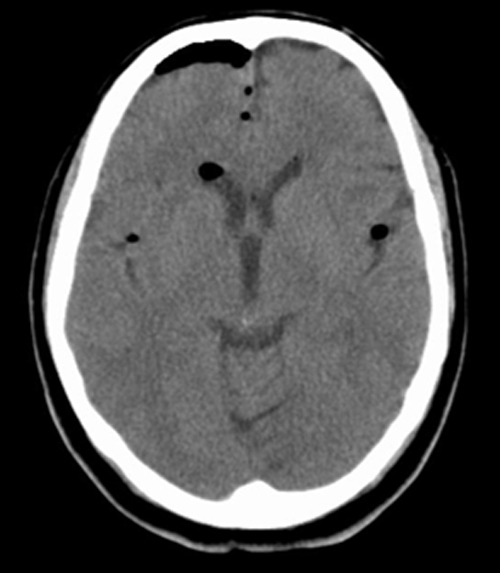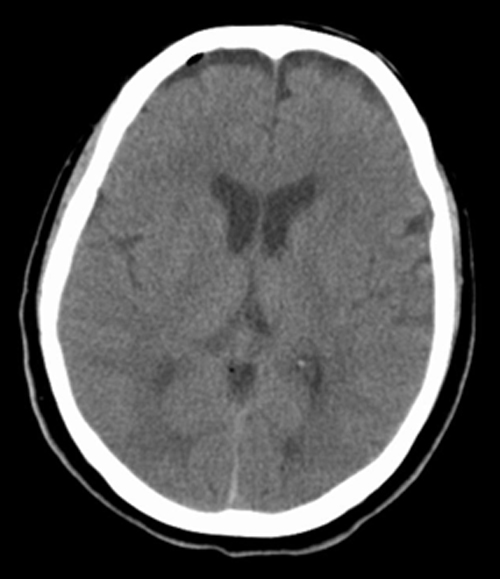*Assistant Professor, Department of Anesthesiology and Reanimation, Faculty of Medicine, Ataturk University, Erzurum (Turkey)
Correspondence: İlker İnce, MD, Assistant Professor, Department of Anaesthesiology and Reanimation, School of Medicine, Ataturk University, TR-25240 Erzurum (Turkey); e-mail: ilkerince1983@yahoo.com; Phone: +90 507 243 75 47
ABSTRACT
Various complications have been associated with epidural block; pneumocephalus is one of the rare complications. We report a case of pneumocephalus following epidural catheter placement in a 58 years old female patient referred to our pain clinic for pain hypogastrium. After careful history and physical examination the diagnosis of neuropathic pain was established. The pain did not relieve with the pharmacological treatment, so superior hypogastric ganglion block was performed. The patient remained pain free for a week, after which the complaints recurred. Then an epidural catheter was attempted twice but abandoned after two failed attempts.The catheter perforated the dura mater leading to flow of CSF. After a few hours the patient developed a complaint of severe headache. The patient was hospitalised and intravenous NSAID’swere started. However, the headache did not relieve, so CT scan brain was ordered, which determined the presence of pneumocephalus. The patient was offered symptomatic treatment and after a week was discharged home without any complication.
Key Words: Neuropathic pain; Epidural catheter; PneumocephalusCitation: İnce I, Ahiskalioglu A, Aksoy M, Dostbil A, Celik M. Pneumocephalus after lumbar epidural catheter: a case report. Anaesth Pain & Intensive Care 2014;18(2):186-188
INTRODUCTIONLumbar epidural block is widely used for anesthesia as well as for pain management. However, various complications have been associated with epidural analgesia with or without catheterization. Pneumocephalus is one of the rare complications and has been reported as case reports only.1 The reason for pneumocephalus may be accidental dura puncture during epidural anesthesia or injections of pain medication.2 The incidence of the accidental puncture of the dura mater is between 1 and 2% 3and 2 to 4 ml of air can cause pneumocephalus.4It has also been reported after blood patch application.4,5 We report a case of pneumocephalus after accidental dura puncture twice in the same patient. The condition was diagnosed on CT scan and managed conservatively.
CASE REPORT
A 58-year-old female patient was referred to our pain clinic due to severe pain hypogastrium and dysuria. Her hospital record revealed that she had been hospitalized six months back in the urology service due to bladder cancer and was treated with endoscopy and BCG (Bacillus Calmette-Guérin) instillation for immunotherapy. Later on she was diagnosed to be suffering from tuberculosis of urinary bladder and her complaint of dysuria started. In our opinion her pain had a neuropathic origin.Neuropathic painis usually associated with severe pain, suffering, disability and an impaired quality of life.6As a first option, we started pharmacological treatment including paracetamol, amitriptyline, tramadol and gabapentin. However, the pain was not relieved, so an epidural catheter was placed for analgesic boluses, which relieved the patient’s pain. There was no catheter relatedcomplication andit was used without any problem for a week, after which it was accidentally pulled out. We decided to perform a neurolytic block of the superior hypogastric ganglion. The block was performed with absolute alcohol and it successfully relieved the pain for a week. The pain recurred after one week, so we decided to place an epidural catheter again.
Standard epidural protocols were followed; the patient was made to sit on the operating table facing laterally with head flexed and arms wrapped around a pillow. The lumbar area was scrubbed by using povidone-iodine solution. Theskin and subcutaneous tissues were infilterated with lidocaine 2%.An 18G tuohy needle was entered into the L4-5 interspace and an epidural catheter was threaded. However, on aspirationflow of cerebrospinal fluid was observed. The catheter was reintroduced at L3-4 space, but it again punctured the dura, leaking cerebrospinal fluid. It was thought that the leaked CSF was a result of perforation of the dura mater during the first time; but we did not inject local anesthetic solution through the epidural catheterand the process was terminated. At the end of the process the patient complained of headache. There were no symptoms of increased intracranial pressure e.g., blurring of vision, nausea, vomiting or bradycardia etc.
Due to severity of the headache we hospitalised the patient. The headache was not like a post dural puncture headache. Dexketoprofen 50 mg IV was infused but the pain did not relieve. Suspecting a cerebrospinal pathology, we decided to order a CT scan of brain. It showed the presence of pneumocephalus (Figure 1), so the patient was transferred to neurosurgery service.

Figure 1:First CT scan, multiple pneumocephalus. Multiple pneumocephalus, which is the largest in the right frontal lobe
Oxygen was administered by mask and oral dexketoprofen 25 mg was given twice a day for seven days, after which the headache was relieved and the patient was discharged without any neurologic complications.

Figure 2: CT scan four days later, resorbed pneumocephalusMillimeter-sized pneumocephalus in the right frontal lobe
DISCUSSION
After lumbar epidural block, various complications such as hypotension, dizziness, post-dural puncture headaches and motor weakness may occur. In rare cases pneumocephalus also may occur.The headache of pneumocephalus starts immediately and is not relieved by lying down .4 In case of dural puncture headache, the pain can be relieved by lying down. Also it occurs generally 24 to 48 hours later after the dural puncture while it can appear a few minutes or hours later.7
The patient may experience unconsciousness, nausea, vomiting, dizziness and hemiparesis.8 The duration and intensity of the clinic symptoms depend on the amount of air inside the cranium.9 The patient in this current case report experienced only headache. There were no increased intracranial pressure symptoms as blurring of vision, nausea, vomiting, bradycardia etc.
The air disappears in 3–5 days with reabsorption.11 Using air to identify the epidural space has some complications like: retroperitoneal emphysema, failure of the block, delayed reversion of the block,8 cervical emphysema, compression of the cauda equina, gas embolization9 and pneumocephalus.12 Symptoms of pneumocephalus may be a result of increased intracranial pressure.The symptoms are headaches, nausea, vomiting, dizziness, hemiparesis,8 seizures, decreased level of consciousness.13 Pneumocephalus associated headache is usually seen immediately, and is not alleviated by lying down. In our case we used air to identify the epidural space both on the first and second intervention and we saw that the headache started immediately and the pain character was not associated with the patient position. We observed only headache. No other symptoms were seen.
We used CT for diagnosis the pneumocephalus because head CT is the most appropriate diagnostic examination.13 At first, we did not think that the clinical presentation was about pneumocephalus. We thought that it might be a post-dural puncture headache. So we admitted the patient for observation in our pain clinic. After several hours, during clinic follow-up, we saw that the headache was not associated with the patient’s position. So we decided toconduct a brain CT scan. The CT showed that there was pneumocephalus.
Treatment of pneumocephalus is symptomatic. 100% oxygen has been suggested in the supine position.10 We can administerananalgesics to relieve headache.9 Surgery is recommended if tension pneumocephalus occurs.14 We did not need surgical treatment. Our treatment was symptomatic and pneumocephalus was resolved spontaneously in 4 days. After control CT, the patient was discharged without any complications (Figure 2).
As a consequence, implementation of an epidural catheter must be performed carefully. Especially when the dura mater is perforated, we should use saline for epidural space identification and headaches must be evaluated carefully. We should not forget that rare complications may develop as pneumocephalus.
Conflıct of ınterest: Authors declare no conflict of interest
REFERENCES- Hawley JS, Ney JP, Swanberg MM. Subarachnoid pneumocephalus from epidural steroid injection. Headache 2005;45:247–8. [PubMed]
- Nafiu OO, Urquhart JC. Pneumocephalus with headache complicating labour epidural analgesia: should we still be using air? Int J Obstet Anesth 2006;15:237-9. [PubMed]
- Avellanal M, Olmedilla L, Ojea R, Rueda ML, Navia J. Pneumocephalus after spinal anesthesia. Anesthesiology, 1996;85:423-425. [PubMed][Free Full Text]
- Nolan RB, Masneri DA, Pesce D. Pneumocephalus after epidural injections Emerg Med J. 2008;25:416.[PubMed][Free Full Text]
- Ferrante E, Rubino F, Porrinis L. Pneumocephalus: A Rare Complication of Epidural Catheter Placement During Epidural Blood Patch.Headache 2014;54:539-40. [PubMed]
- Tampin B, Briffa NK, Goucke R, Slater H. Identification of neuropathic pain in patients with neck/upper limb pain: Application of a grading system and screening tools Pain 2013;154:2813-22. [PubMed]
- Benzon HT, Linde HW, Molloy RE, Brunner EA. Postdural puncture headache in patients with chronic pain. Anesth Analg 1980; 59: 772-4. [PubMed]
- Van den Berg AA, Nguyen L, von-Maszewski M, Hoefer H. Unexplained fitting in patients with post-dural puncture headache. Risk of iatrogenic pneumocephalus with air rationalizes use of loss of resistance to saline. Br J Anaesth, 2003;90:810-811. [PubMed][Free Full Text]
- Laviola S, Kirvela M, Spoto MR, Tschuor S, Alon E. Pneumocephalus with intense headache and unilateral pupillary dilatation alter accidental dural puncture during epidural anesthesia for cesarean section. Anesth Analg, 1999;88:582-583. [PubMed]
- Kim YJ, Baik HJ, Kim JH, Jun JH. Pneumocephalus developed during epidural anesthesia for combined spinal epidural anesthesia. Korean J Pain 2009;22:163-6. [Free Full Text]
- Gómez-Ríos MÁ, Fernández-Goti MC. Pneumocephalus after Inadvertent Dural Puncture during Epidural Anesthesia. Anesthesiology. 2013;118:444. [PubMed][Free Full Text]
- Kuczkowski KM, Benumof JL. Images in anesthesia: headache caused by pneumocephalus following inadvertent dural puncture during epidural space identification: is it time to abandon the loss of resistance to air technique? Can J Anaesth, 2003;50:159-160. [PubMed]
- Rodrigo P, Garcia JM, Ailagas J. General convulsive crisis related to pneumocephalus after inadvertant dural puncture in an obstetric patient. Rev Esp Anestesiol Reanim 1997;44:247-249. [PubMed]
- McMurtrie R Jr., Jan R: Subarachnoid pneumocephalus: A rare complication of epidural catheter placement. J Clin Anesth 2002;14:539–42. [Pubmed]